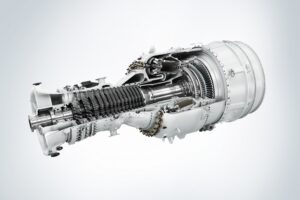Estrella del Mar III, a Visionary Floating Power Plant, Is POWER's Plant of the Year
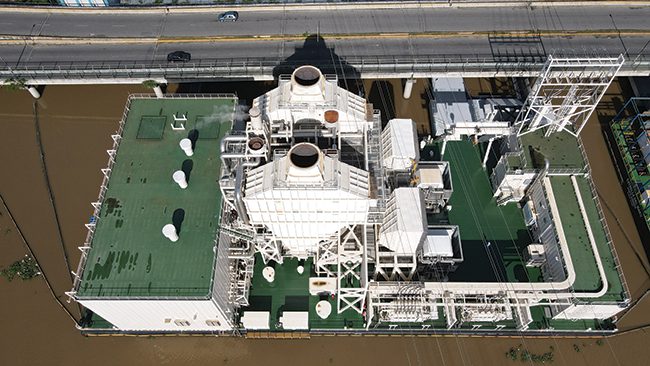
Winning POWER’s highest honor is Estrella del Mar III, a first-of-its-kind floating combined cycle gas turbine power barge that fulfills a remarkable assortment of modern power system demands. Nearly fully built in Singapore by an international team that delicately integrated shipbuilding and power engineering, the pioneering SeaFloat plant sailed more than 10,000 miles for final commissioning in Santo Domingo, capital of the Dominican Republic. The innovative 148-MW project exemplifies an efficient, ecological, economical, and resilient power solution that triumphs over land and cost constraints.
In 2017, Transcontinental Capital Corp., a Seaboard independent power-producing subsidiary, approached Siemens Energy, requesting a power-generating solution that was more efficient and flexible than its current and previously owned fleet of power-generating engine barges in the Dominican Republic. At first, experts at a Siemens Energy (a Siemens spinoff that has operated as an independent, publicly traded company since 2020) gas turbine production campus in Finspång, Sweden, proposed a standard natural gas–fired land-based power plant. But when Seaboard insisted that the solution would need to be a floating power barge due to space constraints, Finspång re-assessed the feasibility of floating a full-size industrial gas turbine power plant and ultimately accepted the challenge.
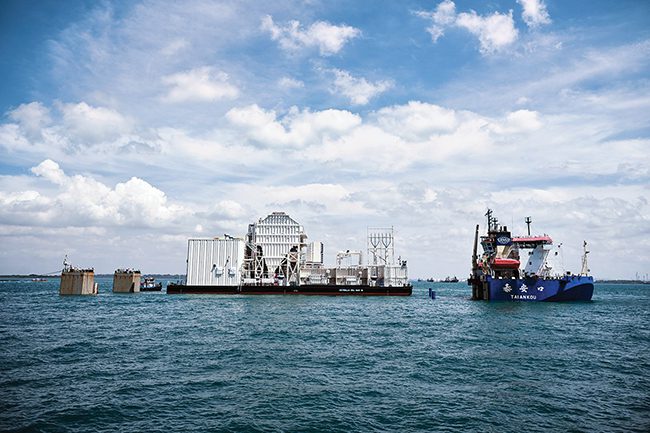 |
|
1. Estrella del Mar III begins its journey across the world from Singapore, where it was built, to its destination on Ocoa Bay, Santo Domingo, Dominican Republic. Courtesy: Siemens Energy |
“That’s how it started,” Jakob Tyroller, General Project Manager of the Estrella del Mar III, told POWER. Over the next few years, the project quickly garnered steam. Bolstered by a landmark collaboration with the marine arm of Singapore engineering group ST Engineering, the complex first-of-its-kind project took shape on a self-supporting barge at a shipyard in Singapore. Following a challenging 46-day journey spanning 14,000 nautical miles across the world onboard a heavy-lift semi-submersible vessel (Figure 1), the nearly completed plant arrived at its destination on Ocoa Bay, Santo Domingo. On June 1, 2022, with hot commissioning wrapped up, the project—a vision realized—was officially delivered to Seaboard.

But Estrella del Mar III is also POWER’s 2023 Plant of the Year award winner because the pioneering project showcases an array of industry integration. Leveraging power and marine engineering under a uniquely forged intercontinental partnership, the project is expected to strengthen competence and floating power solutions. In addition, the flexible gas turbine combined cycle power plant—which can be easily modified for combusting hydrogen as needed— integrates a battery energy storage solution, ensuring Estrella del Mar III will be equipped to address present and future hurdles anticipated within a rapidly changing power landscape. Today, while the plant ensures the reliability of a power-hungry region, it also provides cost-effective power, and according to its owner, it is the most efficient power plant in the Dominican Republic’s power system.
A Custom Solution
Floating power plants aren’t novel—they have been used widely as a source of flexible decentralized power generation for decades, mainly because they can be built cost-effectively and rapidly, and they are mobile, which means they can be relocated and traded. In addition, they can be deployed even in the most remote locations and under challenging ambient conditions, both for temporary or permanent power. But for Seaboard’s Transcontinental Capital Corp., power barges win out over land-based plants for two additional key reasons. The first is that they avoid land constraints and related costs in dense urban environments. And second, the company holds lengthy experience owing and operating power barges.
In 1990, when Transcontinental became the first independent power producer in the Dominican Republic, it initiated operations with the 40-MW Estrella del Norte, a barge equipped with Wärtsilä reciprocating engines. In 2000, it installed a second 72-MW Wärtsilä-engine barge, Estrella del Mar (it sold both barges in 2009). And in 2012, it began operating a third barge, the 104-meter(m)-long Estrella del Mar II. Comprising six Wärtsilä 18V50DF dual-fuel engines in combined cycle mode, the 108-MW facility continues operations. Seaboard has publicly disclosed, however, that it is exploring the sale or relocation of the barge.
In 2017, the company complied with a state request to replace the barge’s power with a new natural gas–fired power plant ostensibly to reap efficiency gains with a smaller emissions profile. A critical key challenge Seaboard faced was to keep costs competitive. “For Seaboard’s Power segment, the Dominican government sets a cap on the electricity spot market prices and establishes the dispatch order of who sells into the power grid based on a merit list. To sell to the power grid, Seaboard competes with producers utilizing various types of fuel and generation technologies, including hydro, solar, wind, natural gas, heavy fuel oil, diesel or coal,” Seaboard explained in recent financial documents. “Typically, dispatch is done based on a merit list with lower-cost power plants dispatched before those with higher costs,” it said.
After exploring the feasibility of a natural gas-fired barge-mounted power plant with a capacity of up to 150 MW with Siemens Energy, Seaboard in November 2018 contracted a consortium comprising Siemens Energy and ST Engineering’s marine arm for a SCC-800 2x1C SeaFloat power plant. Under the contract, the consortium set out to provide a “turnkey plug-and-play” concept. Heading up the power portion, Siemens Energy assumed the task of supplying two SST-600 steam turbines, and two once-through steam generators (OTSGs). In addition, Siemens Energy provided a 5-MW/10-MWh BESS for frequency regulation control. The hybrid solution was designed to help “the plant to operate at full capacity with highest fuel efficiency,” and “at a lower cost [compared to a] similar land-based power plant,” Siemens Energy noted.
ST Engineering’s Marine segment, which is an established turnkey shipbuilder, meanwhile, took charge of the engineering design, procurement, and construction of the self-supporting barge, the balance of plant, transport of the floating power plant to the Dominican Republic, and installation of the floating power plant. ST Engineering also assumed the task of building the plant on the barge at its Benoi shipyard in Singapore.
All Hands on Deck
From the start, the team set out a rigorous work plan to meet a tight timeframe of 28.5 months. The first task involved designing the first-of-its-kind power plant with a blank slate. “We started with a plate of steel,” recalls Tyroller.
The team’s crucial challenge was to fit all the project’s components on a barge, including its liquefied natural gas fuel supply. Other considerations included ensuring the barge wouldn’t block the river and that its height clearances wouldn’t exceed bridges on the Ozama River.
In Singapore, an ST Engineering team pooled multiple software programs to digitalize the entire design process, including 3D modeling, stress analysis, and optimization solutions. Simulations, notably, included noise emissions from structural-borne and airborne noise contributors. “Given the complexity of the process and high voltage systems, we are taking every precaution to ensure that all operations are meticulously planned and carried out. Mitigations include engaging consultants, endless hours of review, and detailed studies of the systems that would become part of the floating system,” noted Terry Heng, ST Engineering Marine’s Project Engineer, in 2019 as the project was well underway.
“Seaboard’s engineers formed an integral part of the overall team in Singapore and the Dominican Republic, supporting with their vast knowledge on power barges during design, construction, and commissioning,” added Tyroller. “Working together as one team made the project successful, despite the various obstacles.”
Engineering a Marvel
Among the project’s many other notable design elements is that it incorporated energy re-generation and wastewater pollution control “in a bid to achieve positive environmental impact,” ST Engineering reported. “Energy re-generation was achieved by channeling the exhaust from the gas turbine through the [two OTSGs] to generate pressurized steam to run the steam turbine. The re-using of exhaust heat energy allows the steam-water cycle to produce cleaner energy. At the same time, it significantly improves the plant’s overall efficiency from 37% up to 56%,” it said.
The OTSGs, which were elevated above the gas turbine at Estrella del Mar III, feature advanced materials suited to temperatures as high as 600C to withstand the full impact of the gas turbine exhaust. The OTSGs also utilize small-diameter tubes and modular construction, allowing for a lightweight and compact design. And because the OTSGs have once-through flow paths, no steam drums or blowdown systems were required.
Meanwhile, Siemens Energy’s industrial gas turbine engineering and manufacturing team in Finspong, Sweden, and the steam turbine innovation campus in Goerlitz, Germany, also set to work to tackle the power plant’s weight and size. To fit on a barge 80 m long and 35 m wide, the power barge needed to be 50% the size of a regular comparable plant. But though optimized for weight and size, Estrella del Mar III weighs 9,300 tons (“a ton less than the Eiffel Tower,” Siemens Energy noted).
Siemens Energy’s solution was to utilize first-of-a-kind single-lift package designs. “It’s the gas turbine, the gearbox, and the generator, all [placed] on one base frame,” noted Tyroller. “And the same for the steam turbine,” he said. Components from Siemens Energy’s production facilities were sent to Hamburg, Germany, where they were placed on a base frame and then shipped to Singapore as “three big pieces instead of multiples,” he said. At the shipyard in Singapore, the modules were further combined as blocks on land before being lifted onto the barge (Figure 2).
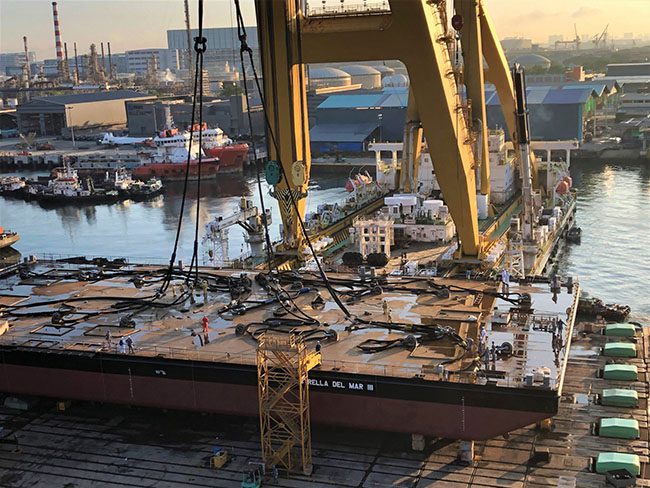 |
|
2. Estrella del Mar III’s construction was carried out at ST Engineering’s Benoi shipyard in Singapore. To maximize space utilization, each component is optimized with regard to function and footprint. For example, the SGT-800 is used as a pre-assembled single-lift complete package with a small footprint. Courtesy: ST Engineering |
The innovative design also features a three-point mount. “If you build on a floating device, you have to address the challenge of motion—roll and pitch, as well as accelerations and deflection,” noted Hamed Hossain, Business Owner of Siemens Energy’s SeaFloat segment. “The three-point mount foundation decouples the deflection of the hull and the gas turbine itself.” Hossain noted that the plant is designed with” a three-degree roll and pitch limitation.”
Despite the tight configuration to optimize power density, the plant is designed to facilitate operations and maintenance, Hossain added. “There’s enough space available,” he noted (an interactive tour of the plant can be accessed here). “The beauty is there is a sliding concept that means you just open the doors of the SGT-800 package, slide out the gas turbine core, and bring in, for example, a spare core into the gas turbine package—which could take around 48 hours maximum. So, the exchange is very fast,” he said.
A New Adaptation for the SGT-800In 1998, after three years of development, Siemens (now Siemens Energy) introduced the SGT-800 to the market. At the time, the single-shaft engine—composed of a 2-bearing rotor with a 15-stage compressor and a 3-stage turbine—was geared to rapidly shifting market conditions that demanded optimized performance, a reduced environmental footprint, as well as high availability and reliability. The industrial gas turbine’s evolution over the past 25 years has benefitted from prototype testing, more than 7 million equivalent operating hours from more than 370 gas turbines sold worldwide, computational updates, and manufacturing and material advances, and today, its rating has ramped up from an initial 43 MW(e) to 62 MW(e).
A driver for recent advancement has been to meet growing flexibility and fuel diversification needs. Siemens Energy notes the turbine model can be fired solely with natural gas, diesel No. 2, or dual fuel with an on-load fuel changeover capability. The fuel flexibility, enabled by DLE burners on the engine, can also burn a high content of inert gases. Along with a 75% volume of hydrogen, that includes heavy hydrocarbons in the gas fuel composition. For Estrella del Mar III, however, the midsize turbine model was a perfect fit owing to space constraints on the floating vessel, said General Project Manager Jakob Tyroller. In addition, the model’s low gas supply pressure requirement (27–31 bar[a] / 390–450 psi[a]) reduced the need for a gas compressor on site. Siemens Energy notes, however, that its SeaFloat power plant range provides a choice of different sizes of combined cycles ranging from aeroderivatives (the SGT-A35 model) via smaller-sized gas turbines with SGT-400 or SGT-750 to heavy-duty gas turbines (with the SGT-8000H). The technology choice is typically optimized to project specifications for power output, efficiency, and load regime, and applications can be customized to different types of floating devices, such as a simple barge (demonstrated by Estrella del Mar III), typical oil and gas platforms, floating production and offloading units (FPSO), or floating storage regasification and power units (FSRPU). While the open-cycle series would be a better choice to balance out high fluctuations in power demand and supply (such as from offshore wind farms), SeaFloat plants with larger heavy-duty turbines could substitute old power plants without brownfield risks, the company suggests |
Overcoming a Series of Challenges
The biggest risk the project faced, according to Tyroller, was from its transportation from the shipyard more than 10,o00 miles to its destination in Santo Domingo (Figure 3). When it set sail in March 2021 after a short dry-docking onboard a heavy lift semi-submersible vessel, the plant was only missing its final stack piece. “The concept was totally new for us,” Tyroller noted. “It’s the biggest stress on the equipment because that’s where you have the [most] motion, going overseas. At the final destination, where it’s a river, it’s fairly calm,” he noted.
 |
|
3. Getting Estrella del Mar III to its destination in Santo Domingo involved a 46-day journey. The transportation route took the plant through the Strait of Malacca, a narrow stretch of water between the Malay Peninsula and Indonesia, past a wide stretch of the Indian Ocean, and around Africa, where it entered the Atlantic Ocean, and finally, the Caribbean Sea. The plant reached its destination on Ocoa Bay on April 28, 2021, and it was commissioned on June 1, 2022. Courtesy: ST Engineering |
Compounding the challenge was working within the limited time that the team had access to a dry tow vessel, which tugged the barge to its final site. “The difficulty with a dry-tow vessel is you have to book it well in advance to get a window, and when they show up, you better be ready,” said Tyroller. Dry-tow vessels (Figure 4) are “very rare and very expensive, so you could lose several months if you miss it,” he said. However, the 46-day journey was mostly smooth, he noted.
Another insidious risk was posed by the COVID pandemic. “Singapore was shut down for many months,” Tyroller recalled. “Then, at a certain time, you could go in and get two weeks quarantine in a hotel room. So, getting people there and equipment there was incredibly difficult during those times.”
What does it take to build a barge for a floating power plant that provides a highly efficient, mobile, and self-supporting energy supply? This video from ST Engineering shares how the multinational team pooled together technologies and engineering expertise to build Estrella Del Mar III. Courtesy: ST Engineering
Hot commissioning of the first-of-the-kind project also furnished the project with new trials. During commissioning, two hurricanes passed closely in the Caribbean Sea, though the plant suffered no damage. The global supply chain crunch exacerbated by the Russian-Ukraine war in early 2022, meanwhile, rendered new difficulties to replace the project’s first-of-a-kind gearboxes owing to a shortage of cargo planes.
The delays were costly, but the effort paid off immensely. “As a consortium, we always have the common goal in mind—to deliver the SeaFloat to Seaboard and show how we can make a difference,” said Tyroller. “This is a groundbreaking project for us, which has now been transferred to commercial operation. Together with our customers and partners, the entire team has shown immense strength and perseverance throughout the project, through the various phases. We should all be proud of this common success and celebrate this great achievement of our first highly efficient hybrid power barge.”
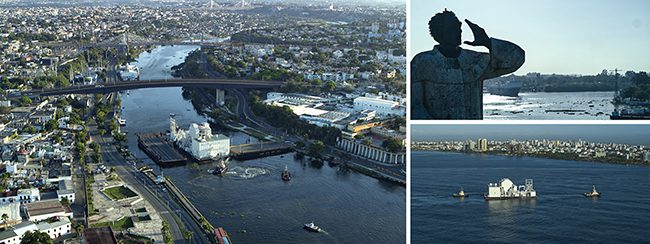 |
|
4. Estrella del Mar III’s arrival in the vibrant city of Santo Domingo, the Dominican Republic’s capital. Courtesy: Siemens Energy |
A New Generation of Floating Power Plants
According to Hossain, the project to develop and build Estrella del Mar III has been pivotal on several different levels. The integration of power engineering and marine engineering has served up myriad benefits, he noted. Along with successfully generating a refined design and power equipment fit for floating power, the design provides optimal space utilization and high power density. It ultimately also broadened workforce horizons. “The Singapore construction team was made up of people from very different occupations, from shipbuilders to power plant engineers. Engineers had to get to grips with nautical terms, such as port and starboard, fore and aft,” he noted. “They learned what a booby hatch is (the enclosed stairway from the main deck into the hull), and different terms for walls, depending on how they’re used (frames or bulkheads).”
Finally, as Siemens Energy’s first SeaFloat project, Estrella del Mar III has demonstrated crucial market attributes, including the merits of a diversified value chain. For example, building power plants in Asia allows customers to “bring Asian market price level to the entire world,” Hossain said.
“In some countries, the labor costs are very high or labor is not available,” he noted. “These are constraints for independent power producers—our customers—and they would not have these kinds of risks at the end of the day.” The concept will also allow power plant developers to build plants in a safe, controlled environment. Yet another SeaFloat benefit Estrella del Mar III exemplifies is that older power plants can continue running until the new one is completed without disruption to the existing supply.
—Sonal Patel is a POWER senior associate editor (@sonalcpatel, @POWERmagazine).
